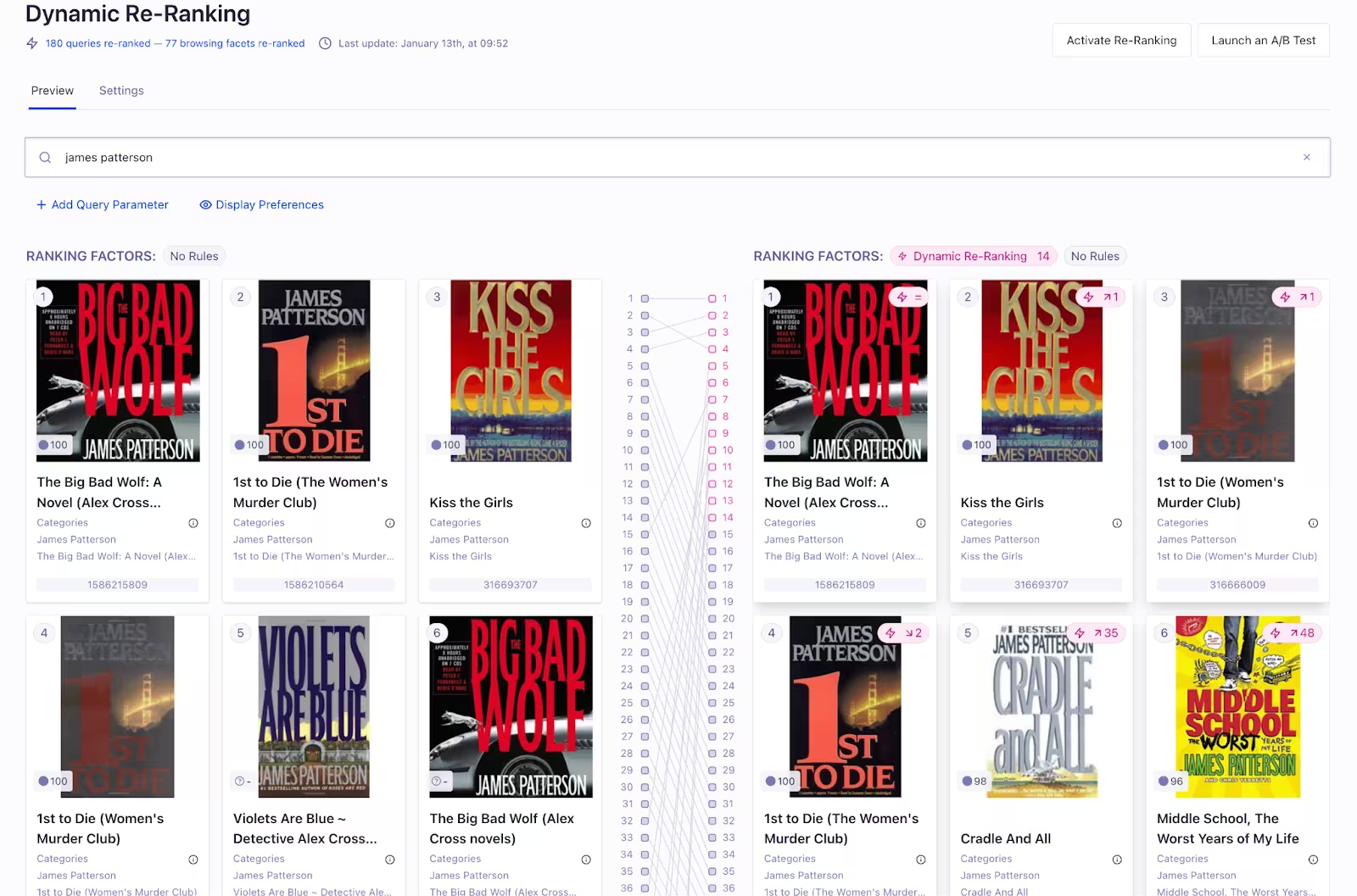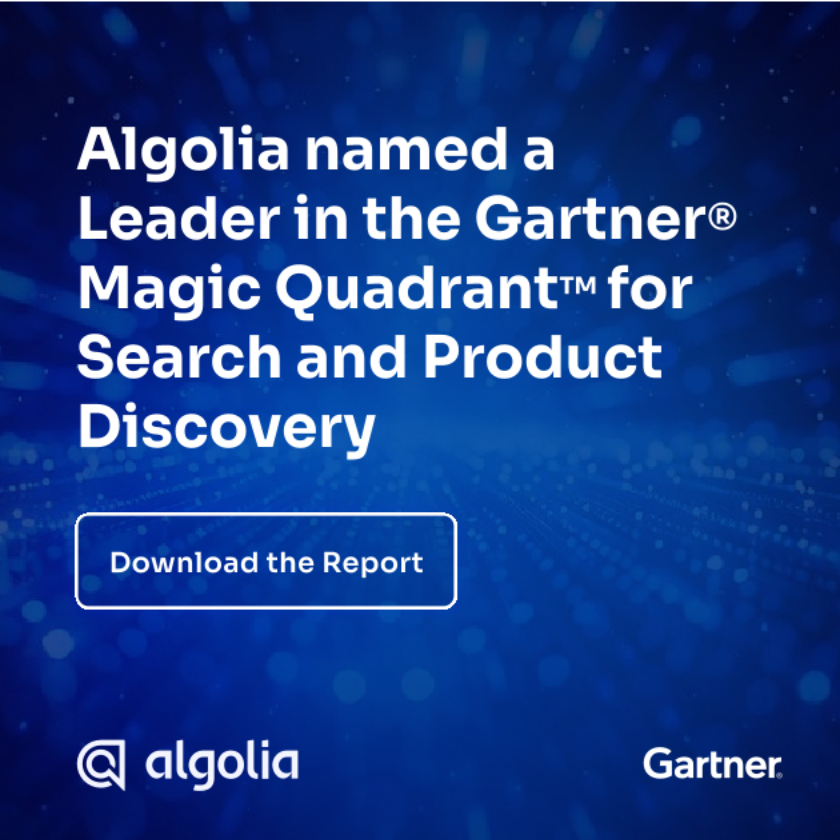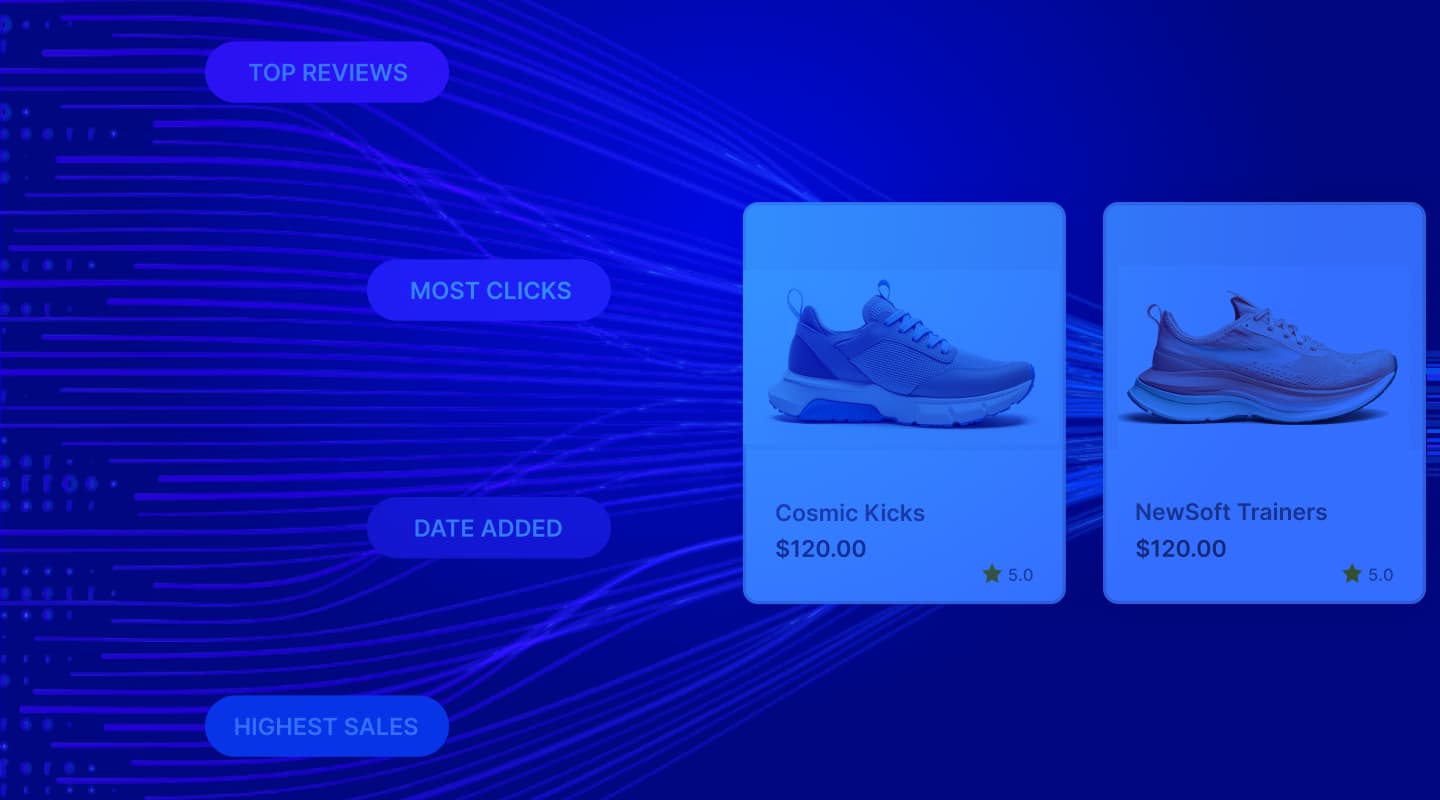Estimated time to read: 5 minutes
A good search experience should provide immediately relevant results. When people search, they expect the results to match their intent, offering exactly what they’re looking for—quickly and accurately. Anything less risks losing their trust and engagement. And at this point in time, it’s hard to argue against this premise. However, search is more than relevance. There's also desirability.
This is about whether the results have been ordered in the most appealing way for you personally. This is also called ranking. For example, if you’re the proprietor of an electronics website, and a customer is searching for a “tv” there can be many equally relevant results. The order of results matters. We know from Google that the top 10 results are the most important, and the top 3 are exponentially important to searchers.
There are many ways to determine how something should rank. At Algolia, our Dynamic Re-ranking (DRR) feature automatically adjusts the search rankings based on trends among your user base. It saves our customers while boosting customer satisfaction and conversion rates. For example, when Gymshark promoted well-established items at the top of the page, those items became responsible for 8.3 percent of click-throughs and 15 percent of overall page revenue. Meanwhile, without it, the top listing was responsible for a mere 3.2 percent of clicks and 3.9 percent of revenue.
In the last few months, we have released several new AI ranking features: Advanced Dynamic Re-ranking, Multi-Signal Ranking, and Dynamic Re-ranking for Revenue. Each of these new features unlocks ranking capabilities that can help retailers drive more revenue, higher AOV, and higher customer satisfaction. When used together, results can be improved exponentially. We’ve bundled these features together (more on this below), and in this blog, we’ll explain how they can unlock great results for your business.

Advanced DRR
Advanced Dynamic Re-Ranking expands the reach of our classic DRR feature with the following improvements:
-
Hourly score refresh: Advanced DRR scores are updated hourly instead of daily, ensuring a timelier reflection of user interactions and preferences.
-
Support for multiple browsing facets: Advanced DRR simultaneously considers multiple browsing facets (not just one!), such as category and brand, providing a more nuanced approach to re-ranking tailored to specific search contexts.
-
Re-ranking of empty queries: For empty queries, Advanced DRR will promote the most popular results overall unless the query is filtered through browsing facets — in which case, a specific re-ranking tailored to those facets will be applied.
Here’s a scenario where this becomes important: Imagine a UK home and garden retailer in early April. Their merchandising is still geared toward spring cleaning and indoor storage - but then, unexpectedly, a heatwave hits. Overnight, customer behavior shifts: searches spike for BBQs, patio furniture, and garden lighting.
In a traditional setup, the merch team might not notice the trend until the next day — or longer. By the time they reconfigure their campaigns, update boosts, and re-prioritise categories, they’ve already missed a wave of intent.
With Advanced DRR, the story plays out differently. The system detects the shift in engagement within the first hour — users are clicking, purchasing, and interacting with outdoor items at a much higher rate. The algorithm quickly reorders results to promote what’s trending right now, without needing any manual changes.
By the time the team logs in the next morning, the top search results are already aligned with customer demand — and sales of outdoor products are climbing.
Multi-Signal Ranking
Let’s say there is a home decor retailer adding a new line of premium scented candles. These are beautifully packaged, well-priced, and clearly aligned with current trends - but because they’ve just been added to the catalogue, they don’t yet have any engagement data: no clicks, no conversions, no favourites.
In a traditional behavioural ranking system, these new products would be buried - because Dynamic Re-Ranking (DRR) relies on real-time signals, and these items haven’t had time to generate any.
That’s where Multi-Signal Ranking (MSR) steps in. MSR extends DRR by applying learned popularity patterns from similar products. It recognises that these new candles belong to a popular category, are priced competitively, and share metadata traits (like brand, scent family, and product type) with other well-performing items. Based on these shared attributes, MSR intelligently boosts the new arrivals - even before they’ve had time to build up their own click history.
The result? The new candles don’t just sit at the bottom of the results page. They get exposure early on, increasing their chances of engagement and conversion - without merchandisers needing to pin or boost them manually.
Learned popularity, social proof, brand, category, and color are just some of the examples; you can choose from just about any event in your system. If you measure something and store that measured data in Algolia, it can probably be used for multi-signal ranking. Other ideas might include popularity, inventory levels, profit margin, promotion status, and more.
What makes Multi-Signal Ranking powerful is its flexibility. You’re no longer confined to a one-size-fits-all relevance model—instead, you can align your ranking logic with business goals, customer behavior, and operational priorities. Whether you're trying to reduce overstock, highlight high-margin items, or simply respond to shifting trends in real time, Multi-Signal Ranking gives you the AI boost to fine-tune your search experience with precision and purpose.
DRR for Revenue
DRR Revenue is our newest AI-powered feature that reorders results based on how they impact your revenue instead of just clicks or conversions. This empowers you to now optimize for popularity and profitability, and it comes fully tuned right out of the box. The wider your product catalog, the more similar results can be reshuffled while keeping the most relevant ones at the top, and the more financial impact using DRR Revenue will make for you.
Imagine a mobile phone merchant selling both high-end smartphones and inexpensive phone cases. On the surface, phone cases convert more often — they’re cheap, easy to buy, and users tend to click on them. But here’s the catch: while cases may drive more conversions, smartphones drive more revenue and require fewer shipments, which reduces fulfillment overhead.
This is where DRR for Revenue really shines. Instead of just promoting what gets clicked most, it optimizes ranking based on what matters to the business. So in this case, DRR Revenue helps the merchant prioritize phones over cases when it makes sense, striking a smarter balance between popularity and profitability.
It’s a small adjustment in ranking logic, but one that reflects a much bigger shift: from vanity metrics to real business impact.
AI is powered by events
To take advantage of AI Ranking (and all AI capabilities for that matter!), you need to be capturing events. Events are small pieces of information sent to Algolia’s servers every time a customer on your site does something significant like browsing, searching, clicking, viewing, adding-to-cart, favoriting, purchasing, etc. In time, with enough data, Algolia’s AI begins to learn your customers’ behavior.
The Algolia Insights API can be used to capture events and send them into Algolia. If you’re not already doing that, you can find our API documentation here or you can connect with someone on our team to learn more.
See how it works today
AI Ranking is available for our Elevate customers, but it’s also now part of a feature bundle for Premium users as well. Talk to an expert to get started with a free trial tailored for customers — and explore how to increase revenue and conversion with AI Ranking.












